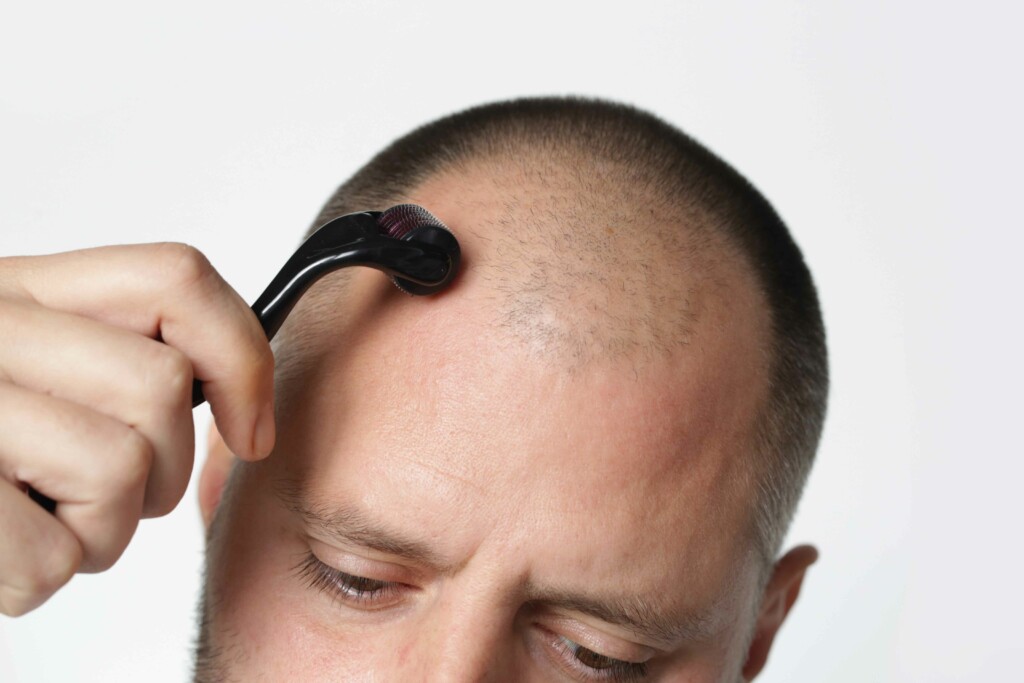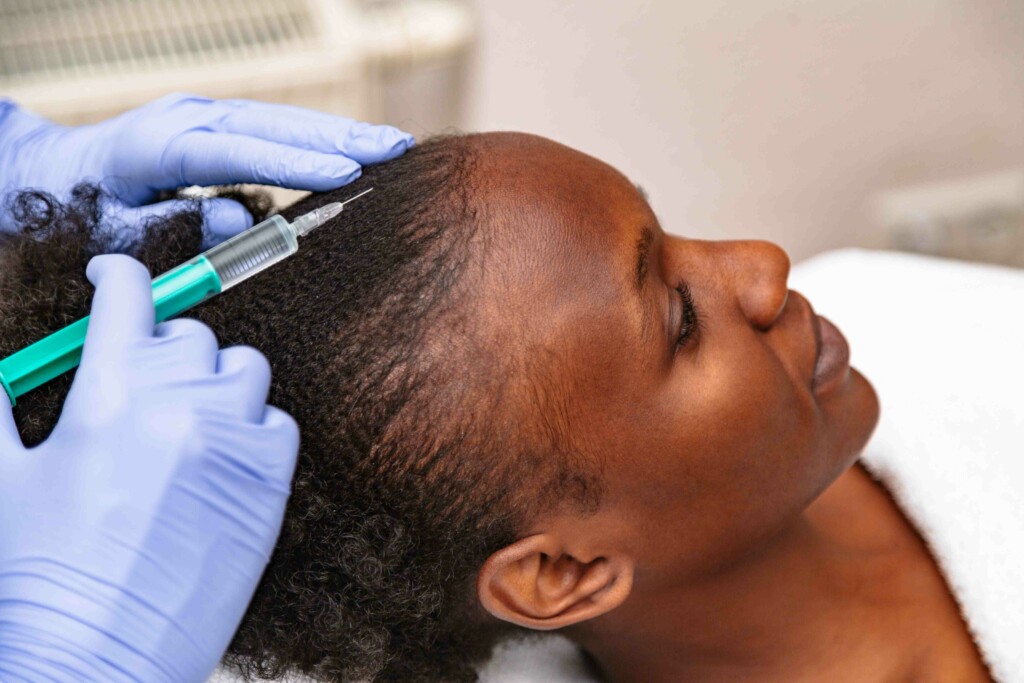Minoxidil is the only topical FDA-approved treatment for androgenetic alopecia. Androgenetic alopecia, commonly referred to as pattern hair loss, involves the progressive reduction in hair follicle size, resulting in hair thinning and hair loss. (1) It occurs in men and women due to a genetic predisposition to hormonal fluctuations that affect the scalp’s hair follicles.
Minoxidil is a vasodilator drug used to widen blood vessels. It was initially used as a treatment for high blood pressure. In the 1970s, when this drug was being tested in clinical trials, some users began reporting an unusual side effect. This side effect – hypertrichosis – was causing increased hair growth on people’s heads and in some cases, all over their bodies. (2) Not long after, word got out that the blood pressure reducer also caused an increase in hair production, presenting a solution to hair loss and balding for the very first time.
Using Minoxidil 2%
Minoxidil 2% was first approved by the FDA for the treatment of androgenetic alopecia in 1987.(2) This topical hair loss treatment is available over the counter and does not require a prescription.
Minoxidil 2% solution is usually applied twice daily to a dry, clean scalp. After, the user should wash their hands and make sure to not get their head wet. Results can start to be seen after at least 8 weeks of consistent use. (2)
Like other hair loss treatments, minoxidil 2% is intended for long-term use. Stopping treatment typically results in a reduction of new growth and the recurrence of hair loss.
Minoxidil 2% Side Effects
It’s unusual for minoxidil 2% solution to cause side effects. Potential issues that can occur when using this product include (2,3):
- Pruritus (severe itching of the skin)
- Scalp dryness
- Scaly or flaky skin
- Inflammation
While this side effect occurs rarely, it’s also possible to experience hypertrichosis when using minoxidil. Hypertrichosis is the scientific term for an excessive growth of hair. While an increase in hair growth may sound positive, this side effect can occur on undesirable places, like the face or hands. (2)
People using minoxidil may also notice symptoms of skin irritation or dermatitis, which may be indicative of an allergy. The allergy could be due to using minoxidil, but it might also be due to an ingredient in minoxidil foam called propylene glycol. (2,3)
If side effects like these persist, talk to your dermatologist as soon as possible. Both dermatitis and skin allergies have the potential to worsen your hair loss. Your doctor will likely suggest that you try using the foam formulation of minoxidil, which is less likely to cause adverse effects as it is often made without propylene glycol, or another FDA-approved option, like oral finasteride or low-level laser therapy. (2,4)
Using Minoxidil 5%
Minoxidil 5% has a higher percentage of the active ingredient minoxidil within its formulation. It was originally created as a liquid solution and received FDA approval for use as a topical foam for androgenic alopecia in 2006.
Minoxidil 5% can be used by men and women. Like minoxidil 2%, it’s meant to be used long-term. Currently, 5% minoxidil is thought to be the most effective minoxidil product for men and women. (2,3,5)
Minoxidil 5% Side Effects
Besides for the differences in the concentration of the active ingredient, minoxidil 2 and 5% are almost exactly the same. But this small difference has meant that minoxidil 5% solution may be a bit more likely to cause side effects like irritation, itching, and hypertrichosis. (3)
The upside is that minoxidil 5% foam is often made without propylene glycol. This means that it has the potential to cause fewer side effects related to allergic reactions. (2)
Using 10% Minoxidil
Unlike minoxidil 2% and minoxidil 5%, minoxidil 10% is not an FDA-approved hair loss treatment. There have been studies testing minoxidil 10% solutions as an alternative treatment for hair loss, but any products sold online are unapproved, off-label uses of this medication.
Minoxidil 10% solution or foam products should not be confused with the FDA-approved antihypertensive treatment Loniten, which can be sold as a minoxidil 10 mg tablet.(6) While oral minoxidil is being tested in clinical trials, there are currently no minoxidil pills or tablets approved to treat hair loss. (7) Oral minoxidil is currently only approved to treat high blood pressure.
Minoxidil obviously works as a hair loss treatment – which means that using minoxidil 10% can also yield some benefits in hair regrowth. In one study, over 55% of people using minoxidil 10% solution reported moderately satisfactory results, including a reduction in bald spots, less hair fall, and significant hair regrowth in 2 to 6 months. (8)
But despite these benefits, minoxidil 10% doesn’t tend to perform any better than minoxidil 5%. In fact, it actually caused more negative side effects than the FDA-approved product. (9)
Minoxidil 10% Side Effects
Higher concentration minoxidil products, like minoxidil 10%, have not been approved as they come with an increased risk of side effects. In addition to the standard side effects of flaking, scaling, itchiness, and inflammation, minoxidil 10% can cause issues like excessive hair shedding and stress. (9)
The side effects associated with minoxidil 10% generally seem to not be worth the risk. In one case, 25% of minoxidil 10% users experienced side effects like lightheadedness and headaches. About 15% of users in the same study were also affected by allergic reactions. This product was also found to increase the risk of hypertrichosis, causing unwanted facial hair growth. (8)
Minoxidil 10 mg Side Effects
Minoxidil 10 mg’s side effects are very different from topical minoxidil’s side effects. Loniten’s side effects include salt and water retention resulting in edema, increased heart rate, and blood pressure fluctuations. Like other forms of oral minoxidil, this medication can cause hypertrichosis, an excessive growth of hair that can occur in unwanted places. (6)
2% vs. 5% vs. 10% Minoxidil
Minoxidil is available in many concentrations. However, the FDA has only approved the use of topical minoxidil 2% and 5% as hair loss treatments for androgenetic alopecia. Any minoxidil 10 % products you may find are not approved treatments for hair loss and may come with an increased risk of side effects. Unless you’re enrolling in a clinical trial, you should probably stick with minoxidil 2 or 5%.
Minoxidil 2% vs 5%
Minoxidil 5% is thought to be more effective than minoxidil 2%. This higher concentration formulation is thought to encourage a larger amount of hair growth and reduce more hair loss. Minoxidil 5% may also cause fewer side effects since it’s available as a propylene-glycol-free foam formulation. (2-5,10)
However, both minoxidil 2% and minoxidil 5% are meant to be used long-term. Minoxidil 5% doesn’t produce any longer-lasting effects compared to minoxidil 2%. After stopping treatment, hair loss tends to revert back to its initial state or worse within 24 weeks. (2-5)
Minoxidil 5% vs 10%
Minoxidil 5% is currently thought to be the most effective FDA-approved minoxidil product for hair loss. However, higher concentration products like minoxidil 10% are sometimes tested with the idea that they may be more effective hair loss treatments.
Unfortunately, higher concentration minoxidil products don’t always yield better hair regrowth results. Studies have found that minoxidil 5% outperforms minoxidil 10%, largely because minoxidil 10% produces similar results with an increased amount of side effects. (8,9)
Minoxidil 5% and 10% can both increase hair regrowth, reduce hair fall, and improve overall appearance. But Minoxidil 10% users experienced a marked increase in side effects, like flaking, itchiness, dryness, and inflammation, and as a consequence, also experienced more stress. In contrast, minoxidil 5% users did not experience as many adverse reactions and had an improvement in their psychosocial outlooks, as well. (9)
There are currently no plans for the FDA to approve higher concentration minoxidil products as hair loss treatments. The only higher concentration minoxidil products currently FDA-approved are minoxidil pills like Loniten, which are blood pressure medications, rather than hair loss treatments.(6) Eventually, a lower-dose oral version of minoxidil may become available, but this medication is still being tested in clinical trials. (7)
What’s the Difference Between Minoxidil 2%, 5%, and 10%?
The main difference between minoxidil 2%, 5%, and 10% are the overall concentrations of the active ingredient: minoxidil. Topical minoxidil 2% and 5% are both approved for the treatment of androgenetic alopecia. Higher concentration products like minoxidil 10% are not approved for the treatment of hair loss.
Minoxidil 5% is thought to yield superior results compared to both minoxidil 2% and minoxidil 10%. While minoxidil 10% produces similar results to minoxidil 2% and 5%, it causes a marked increase in side effects without increasing any benefits.
It seems that the sweet spot among minoxidil products is currently minoxidil 5%. Since this product is available as an FDA-approved topical foam, it also works well for people who are allergic to propylene glycol.
References
- Ho, C. H., Sood, T., & Zito, P. M. (2021). Androgenetic alopecia. In StatPearls [Internet]. StatPearls Publishing.
- Badri, T., Nessel, T. A., & Kumar, D. (2021). Minoxidil. In StatPearls [Internet]. StatPearls Publishing.
- Lucky, A.W., Piacquadio, D.J., Ditre, C.M., Dunlap, F., Kantor, I., Pandya, A.G., Savin, R.C. and Tharp, M.D., (2004). A randomized, placebo-controlled trial of 5% and 2% topical minoxidil solutions in the treatment of female pattern hair loss. Journal of the American Academy of Dermatology, 50(4), 541-553.
- Kelly, Y., Blanco, A., & Tosti, A. (2016). Androgenetic alopecia: an update of treatment options. Drugs, 76(14), 1349-1364.
- Olsen, E. A., Dunlap, F. E., Funicella, T., Koperski, J. A., Swinehart, J. M., Tschen, E. H., & Trancik, R. J. (2002). A randomized clinical trial of 5% topical minoxidil versus 2% topical minoxidil and placebo in the treatment of androgenetic alopecia in men. Journal of the American Academy of Dermatology, 47(3), 377-385.
- US Food and Drug Administration. (n.d.). Loniten Minoxidil tablets, USP Warnings – FDA. Retrieved February 26, 2022.
- Beach, R. A., McDonald, K. A., Barrett, B. M., & Abdel-Qadir, H. (2021). Side effects of low-dose oral minoxidil for treating alopecia. Journal of the American Academy of Dermatology, 84(5), e239-e240.
- Charugulla, S. N., & Ahuja, A. (2016). Clinical Survey with Dermatologists on Benefits and Safety of Minoxidil 10%. Indian Journal of Clinical Practice, 26(9).
- Ghonemy, S., Alarawi, A., & Bessar, H. (2021). Efficacy and safety of a new 10% topical minoxidil versus 5% topical minoxidil and placebo in the treatment of male androgenetic alopecia: a trichoscopic evaluation. Journal of Dermatological Treatment, 32(2), 236-241.
- US Food and Drug Administration. (n.d.). Center for Drug Evaluation and Research – Application 21-812 – Labeling – FDA. Retrieved February 26, 2022.
Last updated March 2023




